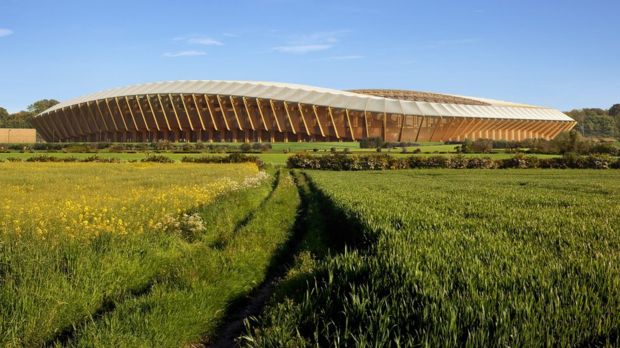
Grenfell fears prevent timber building boom
by Roger HarrabinFears of another Grenfell-type fire are stunting the spread of wood-based buildings in the UK.
The government is planning to reduce the maximum height of wood-framed buildings from six storeys to four.
The move’s been recommended by the emergency services in order to reduce fire risk.
But it contradicts other advice to increase timber construction because trees lock up climate-heating carbon emissions.
In France, President Macron has ruled all new publicly-funded buildings should be at least 50% timber or other natural materials by 2022.
And in Norway a new “ply-scraper” stretches fully 18 storeys – that’s the height recently deemed safe by standards authorities in North America.
18-storey "ply-scraper"
Members of the timber trade say the Government in England has misunderstood the science behind timber construction.
They say timber walls can be made safe by methods including flame-retardant treatments and fire-resistant claddings.
They point out that it is futile planting millions of trees if they are left to rot and release the CO2 they previously captured.

In a consultation ending on Monday, ministers propose the height of timber-based flats, hotels, and boarding houses should be limited to 11 metres – that’s 3-4 storeys.
In higher buildings timber would be permitted in floors but banned from outside walls.
This further tightens rules introduced after the Grenfell disaster, following representation from fire authorities.
Matt Linegar from the Finnish timber giant Stora Enso told BBC News: “Obviously no-one wants to see another tragedy like Grenfell; protecting life is the main concern.
“But the government is over-reacting. Properly-constructed timber buildings can be safe in a fire – it depends on the design.
“Even with the current guidelines introduced after Grenfell there has been a chilling effect on the industry. People commissioning buildings think ‘I’d better not use timber’. The market has virtually dried up.”
'Safe home'
A study from the Germany’s Potsdam Institute (PIK), found that a global boom in wood buildings could lock in up to 700 million tons of carbon a year.
It said a five-story residential building structured in laminated timber can store up to 180 kilos of carbon per square metre - three times more than in the trunk, branches and leaves of natural forests.
PIK’s Hans Schellnhuber said: “Societies have made good use of wood for buildings for many centuries, yet now the challenge of climate stabilisation calls for a very serious up-scaling.
"If we engineer the wood into modern building materials and smartly manage harvest and construction, we humans can build ourselves a safe home on Earth.”
The head of the Committee on Climate Change, Chris Stark, told BBC News: “Timber buildings can be tall and safe. Displacing cement, brick and steel with wood means more than double the carbon savings in buildings overall.
“With encouragement from the Government, we could triple the amount of carbon locked into buildings – one of the simplest steps we can take to help meet the UK’s climate goals.”
A government spokesperson said the consultation responses would be studied before final decisions were made. The fire authorities declined to comment.
Follow Roger on Twitter @rharrabin